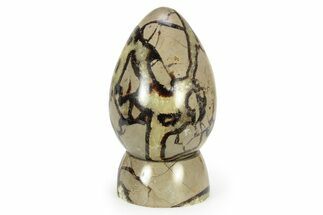This Specimen has been sold.
35" Gorgeous Madagascar Septarian Coffee Table
This is an eye-catching coffee table made from polished septarian pieces mined in the Betsiboka Region of Madagascar. It measures 35.25 x 23.5" and is accompanied by two black, powder coated table legs.
The top of the table is made from pieces of polished septarian that have been mounted in epoxy to create a solid tabletop. The contrast between the grey limestone, yellow calcite, and brown aragonite is quite stunning.
The top of the table is made from pieces of polished septarian that have been mounted in epoxy to create a solid tabletop. The contrast between the grey limestone, yellow calcite, and brown aragonite is quite stunning.
About Septarian
Septarian or septarian nodules are concretions containing angular cavities or cracks, called "septaria", filled with calcite and aragonite. A concretion is a hard, compact mass of rock that often forms around decaying organic matter. In the case of septarian nodules, the concretions formed around decaying sea life in a marine environment.
The exact mechanism for how the cracks form in the concretions is a mystery. One possible mechanism is the dehydration of the clay-rich core of a concretion, causing it to shrink and crack. The cracks could also be caused by gas expansion produced by the decaying organic matter within a concretion. Earthquakes have also been suggested as yet another mechanism.
The cracks in the concretions are then filled in with minerals such as calcite (yellow), aragonite (brown), and sometimes pyrite, causing very interesting patterns. They have often been described as looking like dragon's skin. They are frequently found as geodes with hollow, calcite crystal-filled cavities. More rarely, the fossils that originally started the formation of the concretion are still preserved in the septarian.
Septarian or septarian nodules are concretions containing angular cavities or cracks, called "septaria", filled with calcite and aragonite. A concretion is a hard, compact mass of rock that often forms around decaying organic matter. In the case of septarian nodules, the concretions formed around decaying sea life in a marine environment.
The exact mechanism for how the cracks form in the concretions is a mystery. One possible mechanism is the dehydration of the clay-rich core of a concretion, causing it to shrink and crack. The cracks could also be caused by gas expansion produced by the decaying organic matter within a concretion. Earthquakes have also been suggested as yet another mechanism.
The cracks in the concretions are then filled in with minerals such as calcite (yellow), aragonite (brown), and sometimes pyrite, causing very interesting patterns. They have often been described as looking like dragon's skin. They are frequently found as geodes with hollow, calcite crystal-filled cavities. More rarely, the fossils that originally started the formation of the concretion are still preserved in the septarian.
SPECIES
Septarian with Calcite
AGE
LOCATION
Ambondromamy, Betsiboka Region, Madagascar
SIZE
35.25 x 23.5", 17" tall with base, weight 56 lbs
CATEGORY
ITEM
#303665
 Reviews
Reviews















